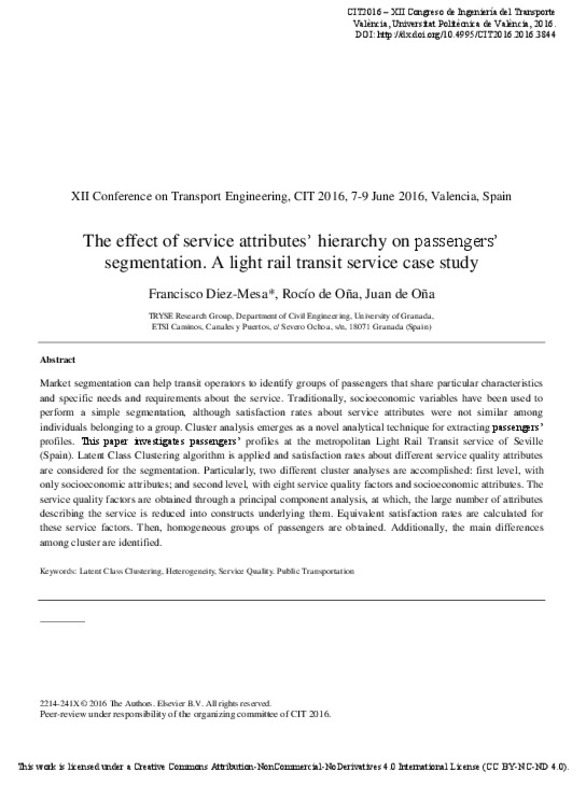JavaScript is disabled for your browser. Some features of this site may not work without it.
Buscar en RiuNet
Listar
Mi cuenta
Estadísticas
Ayuda RiuNet
Admin. UPV
The effect of service attributes’ hierarchy on passengers’ segmentation. A light rail transit service case study
Mostrar el registro sencillo del ítem
Ficheros en el ítem
| dc.contributor.author | Diez de los Rios Mesa, Francisco
|
es_ES |
| dc.contributor.author | De Oña López, Rocío
|
es_ES |
| dc.contributor.author | De Oña López, Juan
|
es_ES |
| dc.coverage.spatial | east=-5.984458899999936; north=37.3890924; name=Recaredo (Puerta Carmona), 41003 Sevilla, Espanya | |
| dc.date.accessioned | 2017-11-03T11:57:48Z | |
| dc.date.available | 2017-11-03T11:57:48Z | |
| dc.date.issued | 2016-06-01 | |
| dc.identifier.isbn | 9788460899600 | |
| dc.identifier.uri | http://hdl.handle.net/10251/90386 | |
| dc.description.abstract | [EN] Market segmentation can help transit operators to identify groups of passengers that share particular characteristics and specific needs and requirements about the service. Traditionally, socioeconomic variables have been used to perform a simple segmentation, although satisfaction rates about service attributes were not similar among individuals belonging to a group. Cluster analysis emerges as a novel analytical technique for extracting passengers’ profiles. This paper investigates passengers’ profiles at the metropolitan Light Rail Transit service of Seville (Spain). Latent Class Clustering algorithm is applied and satisfaction rates about different service quality attributes are considered for the segmentation. Particularly, two different cluster analyses are accomplished: first level, with only socioeconomic attributes; and second level, with eight service quality factors and socioeconomic attributes. The service quality factors are obtained through a principal component analysis, at which, the large number of attributes describing the service is reduced into constructs underlying them. Equivalent satisfaction rates are calculated for these service factors. Then, homogeneous groups of passengers are obtained. Additionally, the main differences among cluster are identified. | es_ES |
| dc.format.extent | 8 | es_ES |
| dc.language | Español | es_ES |
| dc.publisher | Editorial Universitat Politècnica de València | es_ES |
| dc.relation.ispartof | XII Congreso de ingeniería del transporte. 7, 8 y 9 de Junio, Valencia (España) | es_ES |
| dc.rights | Reconocimiento - No comercial - Sin obra derivada (by-nc-nd) | es_ES |
| dc.subject | Latent Class Clustering | es_ES |
| dc.subject | Heterogeneity, | es_ES |
| dc.subject | Service Quality | es_ES |
| dc.subject | Public Transportation | es_ES |
| dc.title | The effect of service attributes’ hierarchy on passengers’ segmentation. A light rail transit service case study | es_ES |
| dc.type | Capítulo de libro | es_ES |
| dc.type | Comunicación en congreso | es_ES |
| dc.identifier.doi | 10.4995/CIT2016.2015.3844 | |
| dc.rights.accessRights | Abierto | es_ES |
| dc.description.bibliographicCitation | Diez De Los Rios Mesa, F.; De Oña López, R.; De Oña López, J. (2016). The effect of service attributes’ hierarchy on passengers’ segmentation. A light rail transit service case study. En XII Congreso de ingeniería del transporte. 7, 8 y 9 de Junio, Valencia (España). Editorial Universitat Politècnica de València. 2124-2131. https://doi.org/10.4995/CIT2016.2015.3844 | es_ES |
| dc.description.accrualMethod | OCS | es_ES |
| dc.relation.conferencename | CIT2016. Congreso de Ingeniería del Transporte | es_ES |
| dc.relation.conferencedate | June 07-09,2016 | es_ES |
| dc.relation.conferenceplace | Valencia, Spain | es_ES |
| dc.relation.publisherversion | http://ocs.editorial.upv.es/index.php/CIT/CIT2016/paper/view/3844 | es_ES |
| dc.description.upvformatpinicio | 2124 | es_ES |
| dc.description.upvformatpfin | 2131 | es_ES |
| dc.type.version | info:eu-repo/semantics/publishedVersion | es_ES |
| dc.relation.pasarela | OCS\3844 | es_ES |








